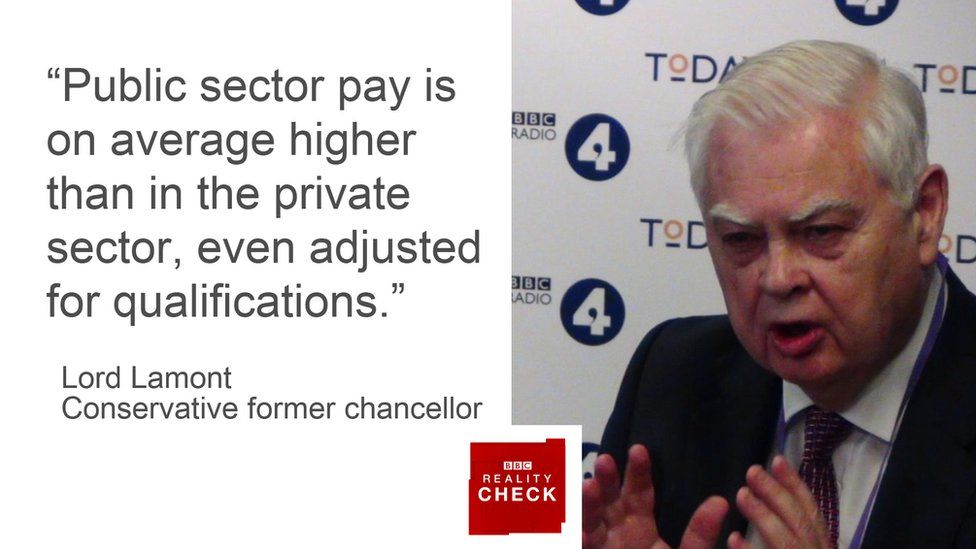Reality Check: Is public sector pay higher than private sector?
- Published

The claim: Average public sector pay is higher than private sector, even adjusted for qualifications
Reality Check verdict: It is a difficult comparison to make, but IFS calculations suggest that Lord Lamont is probably right. However, in recent years private sector pay has been growing faster than public sector pay and the gap between public and private pay is expected to continue to narrow in the coming years if current government policies are implemented.
Former chancellor Lord Lamont was on Radio 4 on Monday morning championing the case for continued pay restraint.
He pointed out that public sector pay in Great Britain is above private sector even taking into account qualifications.
The point about qualifications is important, because jobs in the public sector tend to require higher qualifications. Also, there has been a tendency for public sector bodies to outsource lower-paid functions such as cleaning and catering to contractors, which moves them from the public to the private sector. Doing so on a large scale would increase average earnings in the public sector.
There tends to be a wider range of pay in the private sector - there are more low earners and more high earners.
If you look at seasonally adjusted average weekly earnings for regular pay in the public sector, it was £506 a week in April, compared with £464 in the private sector.
But Lord Lamont was talking about earnings adjusted for qualifications. The Institute for Fiscal Studies (IFS) made this comparison in May, when it found that average public sector pay was about 3% above the private sector, although it warned that it could only adjust for whether somebody had a degree, for example, and not what the degree was in, or how good a degree it was.
Another thing that makes this comparison tricky is that staff in the public sector tend to have better pension provision, with earnings-related schemes still common in the public sector but unusual in the private. This is not reflected in the average earnings figures.
Bonus payments are more common in the private sector and they are also not included in these average earnings figures.
The gap between public and private sector earnings has been narrowing as a result of two years of frozen public sector pay starting in 2011 followed by 1% caps.
In recent years private sector pay has been growing faster than public sector pay.
Part of this effect has been to catch up with the period around 2009, when, as a result of the financial crisis, private sector average earnings fell substantially, while public sector earnings were much more resilient. During that period the gap between public and private sector earnings grew.
But inflation has been growing faster than both public and private sector pay, meaning that workers have seen their pay fall in real terms.
The IFS has warned that if the government's current plans are implemented, the gap between public and private sector pay will return to levels last seen in the 2000s, when there were considerable difficulties in recruiting and retaining staff.
Public-sector pay growing more slowly than inflation is reflected in a report commissioned by the Office of Manpower Economics published on Monday.
It looked at what had happened to real (adjusted for inflation) median wages for 10 occupations covered by pay review bodies, between 2005 and 2015.
The median wage is the one earned by the person compared with whom half of workers are paid more, and half paid less.
Average hourly pay for doctors has fallen from £38 an hour in 2005 to £30 in 2015, while the average pay of nurses is unchanged at £16 an hour.
Police officers have seen their pay fall from £20 an hour to £18, and teachers' pay is down from £25 to £22.
- Published3 July 2017
- Published3 July 2017
- Published15 May 2017